Pecha Kucha – 20 slides x 20 seconds = 6 minutes 40 seconds (Long Branch Jane’s Walk talk)
Pecha Kucha is a presentations format in which 20 slides are screened at the rate of 20 second per slide.
I like this format because it keeps presentations brief and to the point.
When I began to work on a recent Pecha Kucha presentation for a Jane’s Walk event, I calculated that I’m looking at 20 x 20 = 400 seconds of speaking time, or 6 minutes and 40 seconds.
Taking 180 syllables per minute as a comfortable speaking rate, in terms of my rate of speech at a typical presentation, I decided that 60 syllables per slide would be the outer limit for the syllable count for each slide. This would also allow for an occasional pause between slides.
In case you like math calculations, 60 syllables in 20 seconds means that if I multiply by 3, I arrive at 180 syllables in one minute (that is, 60 seconds) of speaking time.
A conversational speaking rate is a generally a little faster – around 220 syllables per minute is typical of many speakers. Some speakers go way beyond that but it can be hard to catch the content.
Many blog posts at the Preserved Stories website address in more details the topics discussed below. Among them is a blog post with more details – including a recent eye-witness account from Bob Richardson about the fire that occurred in 1958 – related to the history of the Long Branch Hotel.
[Update: We’ve recently made a correction – please refer to an earlier blog post for details – regarding what we had earlier thought was a photo of the Long Branch Hotel but which in fact is a photo of the Eastwood Park Hotel.
[As well, I think of 1958 as a year that has another significance. In my pursuit of understanding world military history, I’ve recently been reading Things fall apart, a novel by Chinua Achebe – published in 1958. In reading about colonial history, sooner or later one encounters the work of Chinua Achebe.]
[End of update]
I’m really pleased that the Jane’s Walks help us to organize and share information about the history of Long Branch. The history is part of a conversation in which we all can learn so many things from each other.
Below are photos and speaking notes for the Long Branch 2013 Pecha Kucha
The slides for my talk are as follows. The draft text is in the caption for each slide.

Long Branch is located in southern Etobicoke. This photo, by Peter Foley, is from our walk of over a year ago in May 2012. This year, in 2013, we organized two such walks.

We began our walks with a display of photos about Long Branch. We also have these photos on a website called Preserved Stories. Jaan Pill photo

We like to ensure that each walk is a conversation not a lecture. We also ensure the conversation doesn’t turn into a one-person monologue. Many different people spoke at our recent walks. Gay Chisholm photo

Mike James and I lead the Long Branch Jane’s Walks. I find it very good to work with another leader who has a different approach as compared to my way of doing things. Jaan Pill photo

We recorded the entire two walks this year using two audio recorders. We made sure we got permission from people to record. We’ve also had some great volunteer photographers to help us out. Gay Chisholm photo
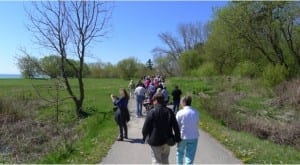
In this photo, we are walking toward the Mississauga / Toronto border. The trail that you see is where Etobicoke Creek used to run in the past, on its way to Lake Ontario. Mike Foley photo
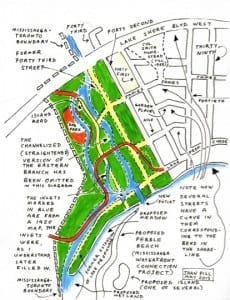
We always provide handouts. This is a cartoon map showing what the area was like when it was cottage country years ago, before Hurricane Hazel arrived in 1954.
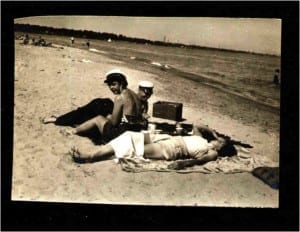
The water was clean in previous years and a great place for swimming. The beach is now part of Marie Curtis Park. This photo shows the beach as it was around the 1940s. Photo © Durance family and Robert Lansdale
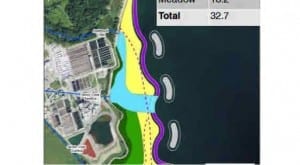
There is a plan to remove the sand beach and replace it with a pebble beach. Once the plans were announced, there were some comments from the community. As a result, part of the sand beach may be saved.

This is Parkview School near Marie Curtis Park. The archaeological remains of the Colonel Samuel Smith homestead are located at the school grounds. The colonel built a log cabin here in 1797. It was demolished in 1955. Peter Foley photo
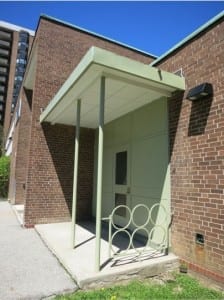
On May 5, we learned that Gresley Elton was the architect who designed Parkview School. We learned about some architectural details – as seen in the photo - that are characteristic of Elton’s work. Jaan Pill photo

Jane and Sid Olvet learned of our May 5 walk through the Jane’s Walk website. Jane’s father was Gresley Elton, who designed many buildings in Long Branch, including the building in the background of this photo. Jaan Pill photo
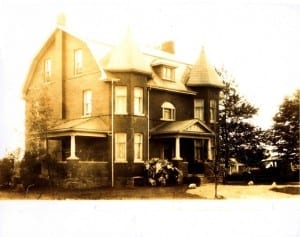
This is actually a picture of the Eastwood Park Hotel. Until he learned otherwise, Jaan Pill had erroneously assumed it showed the Long Branch Hotel, which dates back from the time when the Long Branch Resort was founded in the late 1880s. It burned down in 1958 when someone tried using a blowtorch on some frozen water pipes under the building. CORRECTION: C. O'Marra has on June 3, 2013 kindly sent Jaan Pill the following message: "A correction may have been made since your Jane's Walk report but the photo of the Long Branch Hotel is actually the Eastwood homestead at 37th Street and Lakeshore Blvd. I have the exact photo of it from the old Advertiser newspaper. One of the Eastwood children, and there were at least twelve, is seen in the 1911 picture."
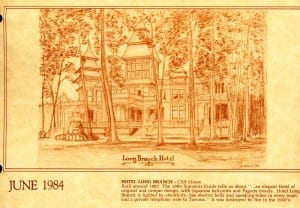
This drawing, from a calendar published by the Long Branch Historical Society, depicts the Long Branch Hotel. It was not included among the 20 Pecha Kucha slides. I include it here to provide a sense of what the hotel looked like.

Before the walks I met with Bill Rawson, who lived in the area in the 1940s. I asked him to draw a map showing where the hotel was located. Bill Rawson map
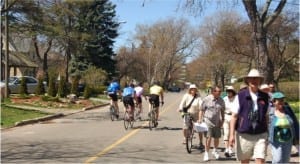
We are now walking toward the Lakeshore Hospital Grounds. This photo is by Gay Chisholm, a volunteer who took pictures for us on the walk on May 4.

In Long Branch, some of the streets terminate as Lake Views facing Lake Ontario. These are public spaces, which were used by the local volunteer fire department to get water from the lake. Jaan Pill photo
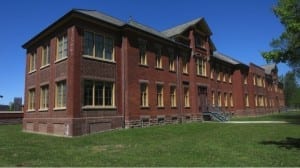
Our walk on May 4 ended at the Lakeshore Hospital Grounds, located in New Toronto. The buildings at the site used to be part of the Lakeshore Psychiatric Hospital. Now they are part of Humber College. Jaan Pill photo
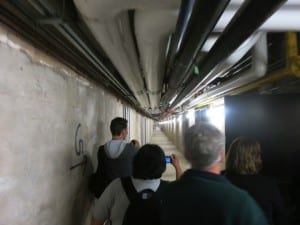
This is a photo of one of the tunnels that connect the buildings at the Lakeshore Hospital Grounds. This is not from a Jane’s Walk but rather from a Doors Open tour of Humber College on May 25. Jaan Pill photo

We did not visit the Lakeshore Asylum Cemetery, which is a ways north of Humber College. We did mention it, however, as it’s relevant to the story of the Lakeshore Hospital Grounds. Jaan Pill photo
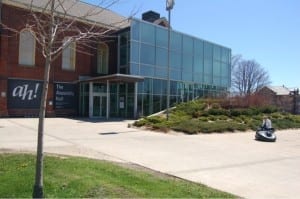
Our walk on May 4 ended at The Assembly Hall near Kipling Avenue and Lake Shore Blvd. West. Formerly part of the Lakeshore Psychiatric Hospital, this century-old building is now used for community activities. Gay Chisholm photo

Leave a Reply
Want to join the discussion?Feel free to contribute!